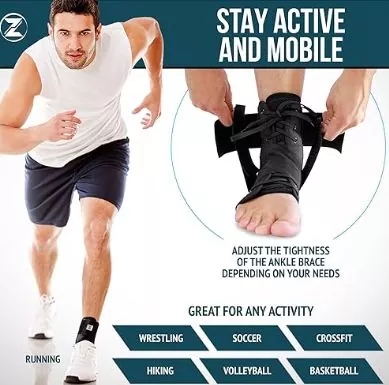
Ankle sprains are common injuries in sports and daily life, and scientific support measures are the core link to promote recovery and prevent secondary injuries. From the acute swelling period to the functional recovery period, the support device provides protection for the injured part through multiple functions, helping the ankle joint return to normal function.

Ankle sprains often come with ligament strain or tearing. Joint stability drops. Small inversion or eversion movements can make ligament injuries worse. Support devices help. These include ankle braces, elastic bandages, and braces. They use external fixation to limit too much ankle movement. They stop dangerous angle movements that cause harm. Take rigid ankle braces. They have support plates on both sides. These plates keep the ankle’s movement within a safe range. This stops patients from spraining again when walking or exercising instability won’t lead to re-injury. It creates a stable place for damaged ligaments to heal.
After spraining, the soft tissue around the ankle joint will become congested and edematous, and increased local pressure will aggravate pain. The support device can promote venous return and reduce swelling by moderate pressure; at the same time, its pressure dispersion effect can reduce the body weight borne by the injured part, so that the injured ankle joint can be "unloaded" when bearing weight. For example, the gradient pressure design of the elastic bandage can not only fix the joint but also accelerate the swelling to subside. Clinical data show that the reasonable use of the support device can reduce the pain level in the acute phase by more than 40%.
The ankle joint needs to stay in its normal shape. This helps ligaments, tendons, and other soft tissues repair. Support devices help keep the joint in the right position. They stop tissues from healing in the wrong place because of odd pressure. Mild sprains need soft ankle braces. These braces fit the ankle’s shape. They hold it gently but steadily. Moderate to severe sprains need functional braces. These braces let you change how tight the fixation is. You can adjust them as you get better. They keep the joint stable. They also give tissues the right kind of mechanical support to heal. This makes the healing time shorter.
Ankle sprains often harm proprioception. That’s the ability to feel where the joint is. This makes patients unsteady when walking—balance gets worse. Support devices fix the joint. They also touch the skin to give feel - based feedback. This helps patients' sense where their ankle is. It slowly brings balance back. In rehab training, you can lower the support bit by bit. This pushes the body to rebuild proprioception. Patients get used to normal walking and exercise faster. It cuts the chance of spraining again.
The selection of an appropriate support method should be combined with the degree of sprain: for mild sprains, elastic ankle braces can be used; for moderate sprains, functional protective gear with steel plates is recommended; for severe sprains, plaster or brace fixation should be used as directed by the doctor. Scientific support measures are an important guarantee for the ankle joint from injury to rehabilitation, helping patients return to daily activities and exercise safely and quickly.